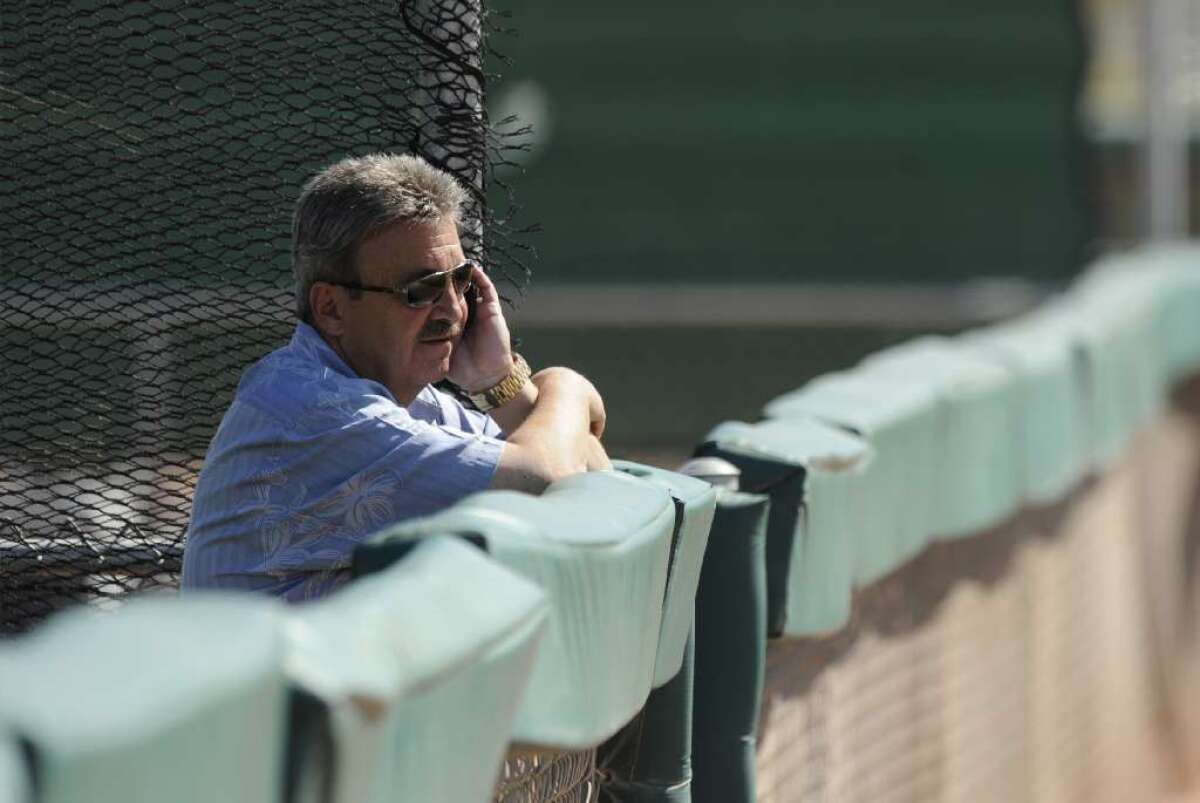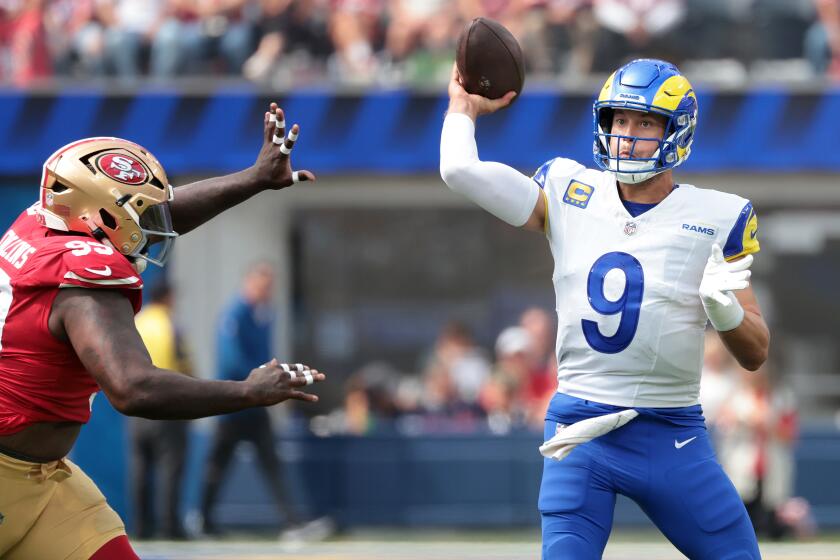Column: He’s no longer in charge, but Ned Colletti’s contributions are still paying dividends for the Dodgers
- Share via
This fall at Pepperdine, students will be offered a class called “The General Manager.’’
It will be taught by a guy who will need no formal introduction, no curriculum vitae, not even a syllabus.
Professor Ned Colletti can just show them a video of Tuesday’s All-Star game.
The careers of the five Dodgers representatives are filled with Colletti fingerprints from his nine-year tenure as Dodger general manager, a job that ended three seasons ago with a legacy that just keeps getting stronger.
Clayton Kershaw, Cory Seager and Cody Bellinger were drafted by Colletti’s regime.
Kenley Jansen was moved from catcher to pitcher under Colletti’s guidance.
Then there’s Justin Turner, who was signed as a minor-league free agent by Colletti in February 2014 and has since blossomed into an All-Star after winning the fans’ “Final Vote’’ polling with a record 20.8 million votes.
Sitting in the Dodger Stadium dugout after his selection was formalized Thursday, Turner was reminded of the day Colletti helped convince him to become a Dodger. Turner was offered a minor league deal because a balky knee caused him to flunk his physical exam, and he could have gone elsewhere for more guaranteed money, but Colletti asked him to bet on himself.
Recalled Colletti: “I told him, ‘You’re my guy, I know you can play, man to man, you are making this team, it’s just a matter of your health.’’
Recalled Turner: “Ned has been so great, so encouraging, a great baseball mind. I no doubt owe him a lot of credit for taking a chance on me.’’
This is how Colletti worked. This is what Colletti did best. He convinced his players to push themselves. He sold his players on their potential greatness. He guided the team to five playoff appearances during a nine-year tenure that included the stormy Frank McCourt era, but it wasn’t enough.

Front offices were changing, and it was judged that Colletti wasn’t changing with them. While he used analytics, he placed a greater reliance on eyes and instincts, and sometimes those failed him. He gave too many big contracts to veterans such as Juan Pierre, Jason Schmidt, Andruw Jones and Brian Wilson. He gave seemingly endless contracts to Matt Kemp and Andre Ethier. Under duress from McCourt’s financial constraints, he traded future star Carlos Santana.
After the Dodgers lost a division series to the better-constructed St. Louis Cardinals in 2014 for a second consecutive playoff failure, it was time for a change. It was a smooth change. The hiring of Andrew Friedman and Farhan Zaidi has worked well. They have led the team to consecutive West Division titles and this summer have constructed what appears to be one of the best teams in Los Angeles Dodgers history.
But Colletti is still here. He was smartly never fired. The Dodgers knew what they had. He is an integral part of this team’s history, his lingering presence a reminder of how they were built and the dreams behind where they are headed.
Colletti, 63, works as an analyst on the team’s SportsNet LA studio shows while teaching at Pepperdine and serving as a mentor for several community groups.
He is a man without a baseball front-office job, but he is not a man without lasting impact. He may be forgotten by those who watch but will be forever remembered by those who play, witness his recent encounter with one of the Dodgers young stars at Chavez Ravine.
It was Seager. Three summers ago, when Seager was a prospect playing in the mid-season Futures Game, Colletti phoned him for a chat.
“I want you to know how I see you,’’ Colletti says he told Seager. “You have a chance to not only be big league player, but great big league player. It’s going to take a lot of work, and it’s not going to come easy, but I see your greatness.’’
When Seager saw Colletti walking through the stadium recently, the kid pulled his former boss aside.
“You remember the phone call you made to me?’’ said Seager.
“I’ll never forget it,’’ said Colletti.
‘Neither will I,’’ said Seager.
It is these memories that keep Colletti involved and engaged in what is surely the most unusual position for an ex-Dodgers official in club history.
“I’m doing great, I love what I’m doing, I’m proud of the organization and where it seems to be going,’’ said Colletti. ‘’Andrew and Farhan are obviously doing a tremendous job. It’s all been very good.’’
Colletti also had an impact on several guys who didn’t make the All-Star team but who play big roles on the hottest team in baseball. Pedro Baez was moved from third base to reliever, Joc Pederson was drafted and Yasiel Puig was signed and made his debut under Colletti’s watch.
“We had a great staff, they all had a special ingredient to them, a little something in their DNA that you don’t always find,’’ Colletti said. ‘’We worked together like iron sharpening iron.’’
That staff included respected executives Logan White, De Jon Watson, Vance Lovelace and Rick Ragazzo. Scouts who were involved in the current All-Stars included Paul Fryer, Calvin Jones, Lon Joyce, Dustin Yount and Brian Stephenson.
Colletti was hoping that every scout and executive who worked for him could be listed in this story. He used everyone’s eyes. He listened to everyone’s voice.
When he ordered his staff to consider moving gifted prospects to new positions if their current positions weren’t working — ‘’It’s incumbent on us to figure out how to get these kids to the big leagues’’ — he was presented with Jansen. After watching Jansen struggle at the plate for the first four years of his pro career, Colletti approved his move to the mound, and then talked Jansen into buying in.
“He fought us in the beginning,” Colletti said. “He didn’t want to move, but I told him, ‘I don’t see you as a big league hitter, I don’t see it happening, being a pitcher is your best chance to get to the big leagues. He finally saw what we saw.’’
On Tuesday, the baseball world will see what Colletti saw, from Seager’s toughness to Turner’s perseverence to Jansen’s cutter.
Colletti won’t be at the game. He’ll be watching on TV. He’ll be thinking about that meeting with Seager. He will be hearing the gratitude from Turner. Maybe Jansen will get the save, and Colletti will smile, and for the old baseball guy who helped build its most forward-thinking team, that will be enough.
Get more of Bill Plaschke’s work and follow him on Twitter @BillPlaschke
More to Read
Go beyond the scoreboard
Get the latest on L.A.'s teams in the daily Sports Report newsletter.
You may occasionally receive promotional content from the Los Angeles Times.











